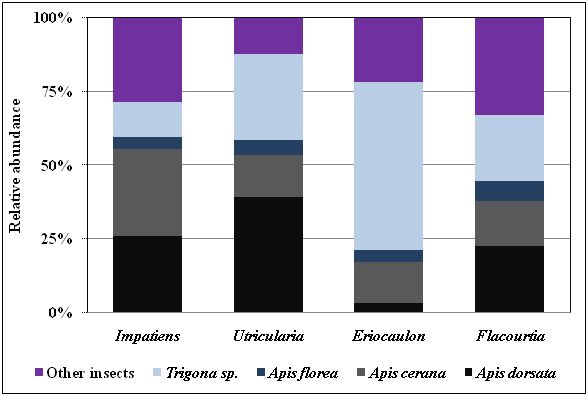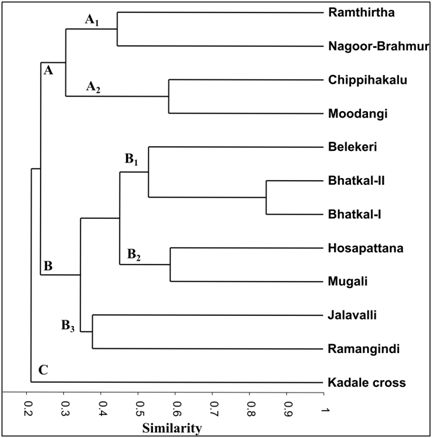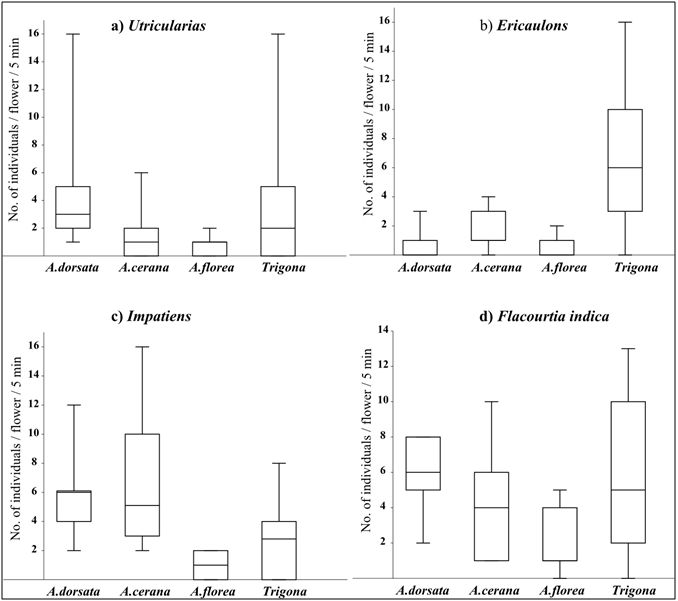Results and discussion
Members of the insect orders Hymenoptera (bees and wasps), Diptera (flies), Coleoptera (beetles) and Lepidoptera (butterflies and moths) constituted the main floral foragers for Utricularias, F. indica, Impatiens and Eriocaulons. Altogether 58 taxa of insects visited the freshly opened study flowers in the 12 study areas (Table 2). The bees, especially honeybees (Family: Apidae) abundant in all stations. In alone work by Hobbhahn et al.36 so far available on insect-related pollination of Western Ghats laterite plateau herbs in Maharashtra and Goa, altogether about 50 species of insects were listed as floral visitors. Some of the taxa which additionally figured in our study included the bee Apis florea, wasps Ropalidia sp. and Vespa cincta, and butterflies Troides minos (Southern Birdwing), Borbo cinnara (Rice Swift), Sarangesa purendra (Spotted Small-flat), Mycalesis patina (Gladeye Bush-brown), Spindasis vulcanus (Silverline), Pachliopta hector (Crimson Rose). The visiting insect community on flowers of F. indica, Utricularas, Impatiens and Eriocaulons were recorded about 24, 14, 14, and 9 insect species respectively. Among the insect species, honeybees (A. dorsata, A. cerana, A. florea and Trigona sp) were visited abundantly rather than other insect community (Figure 2).
Table 2: Inventory of insects associated with plants of lateritic plateaus of coastal Uttara Kannada, South India.
| Family | Species | Common Name | Insects visited plants |
| Lepidoptera | |||
| Hesperidae | Borbo cinnara | Rice Swift | Andropogon sp., Cymbopogon sp., Eragrostis sp., Ischaemum sp., Utricularia spp. |
| Hesperidae | Sarangesa purendra | Spotted Small Flat | Crotalaria spp., Impatiens sp |
| Lycaenidae | Caleta caleta | Angled Pierrot | Ziziphus rugosa, Flacourtia indica |
| Lycaenidae | Castalius rosimon | Common Pierrot | Alternanthera sessilis, Justicia simplex, Tridax procumbens, Ziziphu srugosa, Ziziphus mauritiana, Sida spp. Flacourtia indica, Eriocaulaon sp. |
| Lycaenidae | Spindasis vulcanus | Common silverline | Chromolaena odorata, Canthium coromandelicum, Ziziphus mauritiana, Ziziphus rugosa, Flacourtia indica |
| Lycaenidae | Jamides bochus | Dark Cerulean | Crotalaria spp., Utricularia sp. |
| Lycaenidae | Chilades laius | Lime Blue | Sida spp., Acacia spp., Eriocaulon spp. |
| Lycaenidae | Talicada nyseus | Red pierrot | Acanthaceous herbs, Alternanthera sessilis, Eriocaulon sp. |
| Nymphalidae | Acraea violae | Tawny Coster | Tridax procumbens,Utricularia spp. Flacourtia indica |
| Nymphalidae | Cupha erymanthis | Rustic | Flacourtia indica, Utricularia spp. |
| Nymphalidae | Cynthia cardui | Painted lady | Zornia diphylla, Utricularia spp. |
| Nymphalidae | Danaus chrysippus | Plain Tiger | Calotropis gigantea, Cryptolepis buchananii |
| Nymphalidae | Danaus genutia | Striped Tiger | Tylophora indica, Ceropegia sp. |
| Nymphalidae | Elymnias hypermenstra | Common Palmfly | Caryota urens |
| Nymphalidae | Euploea core | Common Indiancrow | Ficus benghalensis, F. racemosa, Hemidesmus indicus, Ichnocarpus frutescens, Tylophora indica, Flacourtia indica |
| Nymphalidae | Hypolimnas bolina | Great Eggfly | Sida rhombifolia |
| Nymphalidae | Junonia atlites | Grey Pansy | Hygrophila auriculata |
| Nymphalidae | Junonia iphita | Chocolate pansy | Hygrophila auriculata, Justicia simplex |
| Nymphalidae | Junonia lemonias | Lemon pansy | Hygrophila auriculata, Sida rhombifolia, Corchorus capsularis |
| Nymphalidae | Junonia orithya | Blue Pansy | Justicia simplex, Tridax procumbens, Lepidagathis prostrata |
| Nymphalidae | Mycalesis patnia | Gladeye Bushbrown | Oryza spp. |
| Nymphalidae | Neptis hylas | Common Sailer | Corchorus sp., Grewia sp. |
| Nymphalidae | Phalanta phalantha | Common Leopard | Flacourtia indica, Alternanthera sessilis, Smilax sp. |
| Nymphalidae | Tanaecia lepidea | Grey Count | Careya arborea, Melastoma malabathricum |
| Nymphalidae | Tirumala limniace | Blue Tiger | Crotalaria spp., Heliotropium sp., Ageratum conyzoides, Calotropis gigantea, Tylophora indica, Wattakaka volubili, Flacourtia indica. |
| Nymphalidae | Ypthima asterope | Common Three-ring | Tridax procumbens, Grass sp., Eriocaulon sp. |
| Nymphalidae | Ypthima huebneri | Common Four-ring | Tridax procumbens, Clerodendrum serratum, Grass sp., Eriocaulon sp. |
| Papilionidae | Papilio polymnestor | Blue Mormon | Mussaenda frondosa, Ixora coccinia, Jasminum spp., Glycosmis arborea, Zanthoxylum rhets, Flacourtia indica. |
| Papilionidae | Papilio polytes | Common Mormon | Mussaenda frondosa, Ixora coccinia, Jasminum spp., Glycosmis arborea, Zanthoxylum rhetsa Flacourtia indica, Utricularia. |
| Papilionidae | Pachliopta hector | Crimson Rose | Aristolochia indica, Utricularia spp. |
| Papilionidae | Troides minos | Southern Birdwing | Aristolochia indica, Ixora coccinia, Mussaenda frondosa |
| Papilionidae | Graphium agamemnon | Tailed Jay | Ixora coccinia, Mussaenda frondosa, Flacourtia indica. |
| Pieridae | Catopsilia pomona | Common Emigrant | Tridax procumbens, Cassia tora, Flacourtia indica. |
| Pieridae | Eurema hecabe | Common Grass Yellow | Tridax procumbens, Ageratum conyzoides, Acacia spp., Cassia tora |
| Pieridae | Pareronia ceylonica | Dark Wanderer | Capparis sp., Flacourtia indica. |
| Pieridae | Pieris canidia | Indian Cabbage White | Asteraceous plants, Leucas aspera, Impatiens spp. |
| Pieridae | Catopsilia pyranthe | Mottled Emigrant | Cassia tora |
| Pieridae | Anaphaeis aurota | Pioneer or Caper White | Tridax procumbens, Capparis spinosa |
| Pieridae | Ixias marianne | White Orange Tip | Capparis sp. |
| Sphingidae | Cephonodes hylas | Bee-hawk moth | Impatiens spp. |
| Arctiidae | Amata bicinota | Handmaiden moth | Cassia mimosoides, Cassia tora, Eriocaulon sp. |
| Coleoptera | |||
| Meloidae | Unidentified sp 1 | Beetle | Flacourtia indica, Utricularia spp. |
| Meloidae | Unidentified sp 2 | Green blister beetle | Cassia mimosoides, Cassia tora, Flacourtia indica |
| Meloidae | Mylabris sp. | Blister beetle | Cassia mimosoides, Cassia tora, Flacourtia indica, Ixora coccinia |
| Diptera | |||
| Syrphidae | Syrphinids sp. | Hoverfly | Flacourtia indica, Justica simplex, Impatiens spp. |
| Calliphoridae | Lucilia sp. | Blowfly | Flacourtia indica, Justica simplex, Sida sp. |
| Tabanidae | Tabanus sp. | Horsefly | Flacourtia indica, Justica simplex |
| Hymenoptera | |||
| Apidae | Apis dorsata dorsata | Giant or Rock bee | Utricularia spp., Impatiens sp., Flacourtia indica, Bacopa monnieri, Eriocaulon spp. |
| Apidae | Apis cerana indica | Indian bee | Utricularia spp., Impatiens spp., Flacourtia indica, Justicia simplex, Bacopa monnieri, Eriocaulon spp. |
| Apidae | Apis florea | Little bee | Utricularia spp., Impatiens spp., Flacourtia indica, Justicia simplex |
| Apidae | Xylocopa sp. 1 | Carpenter bee | Impatiens spp., Flacourtia indica |
| Apidae | Xylocopa sp. 2 | Carpenter bee | Impatiens spp., Capparis sp. |
| Apidae | Trigona (Tetragonala)sp. | Stingless bee | Eriocaulon spp., Weisneria triandra, Flacourtia indica, Impatiens spp., Justica simplex, Mussaenda frondosa, Ixora coccinia, Jasminum spp., Glycosmis arborea, Zanthoxylum rhetsa, Lepidagathis prostrata, Utricularia spp. |
| Halictidae | Nomia sp. | Sweat bee | Utricularia spp. |
| Vespidae | Polistes sp | Paper wasp | Impatiens spp., Acacia spp. |
| Vespidae | Ropalidia sp. | Paper wasp | Impatiens spp. |
| Vespidae | Vespa cincta | Yellow banded wasp | Impatiens spp. |
| Vespidae | Vespa sp. | Yellow banded wasp | Impatiens spp., Utricularia spp. |

Figure 2: The percentage of insect population visited on the four study plants
The Lepidopteron foragers comprised of 39 butterfly species from 32 genera and 5 families (Table 2). Nymphalidae was most specious (19 sp.) family followed by Pieridae (7 sp.), Lycaenidae (6 sp.), Papilionidae (5 sp.) and Hesperiidae (2 sp.). Two moth species (Bee-hawk moth and Hand-maiden moth) were also recorded, the former already known as an important pollinator. Based on Jaccard’s cluster analysis, relying on butterfly species presence/absence data, the sampling stations are grouped into three basic clusters A, B, and C (Figure 3). Cluster B had the highest diversity of butterfly species, presumably due to more plant diversity. Cluster A was divided into two sub-clusters A1 and A2. Sub cluster A1 consists of two lateritic areas (Ramthirtha and Nagoor-Brahmur), both sharing the taxa namely Borbo cinnara, Sarangesa purendra, Talicada nyseus, and Junonia iphita. Cluster A2 consists of two sampling stations namely Chippihakkalu and Moodangi, hosting about 9 and 10 taxa respectively. Cluster B has seven sampling stations, which are further divided into three sub clusters (B1, B2 and B3). B1 and B2 clusters have similarity to the tune of 55 to 60%. B3 cluster shows nearly 40% similarity with B1 and B2 clusters. B3 site harbored, significantly, important taxa, the Southern Bird-wing, restricted to southern India. The sampling stations of Mugali and Hosapattna of B3 cluster are very important lateritic habitats considering their overall floral richness. Raoet al.16 recorded 125 and 97 species of flowering plants respectively from these two study areas.

Figure 3: Jaccard similarity index for butterfly community in 12 lateritic areas of Uttara Kannada
A. dorsata had a higher visitation rate on Utricularia spp., followed by other honeybees Trigona sp., A. cerana and A. florea (Figure 4a). The average visitation rate of A. dorsata was 4.4 ± S.D 3.6 individuals/flower for 5 minutes, Trigona sp. (3.2 ± 3.6), A. cerana (1.6 ± 1.6) and A. florea (0.6 ± 0.6). Hobbhahn et al.36 study in Maharashtra found that the Utricularias has small quantity of nectar per flower and good concentration of sugar, which attracts the insect visitor and the main pollinator of U. albocaerulea was A. dorsata. Our observations also support the role of Utricularia spp., in providing foraging support to honeybees, especially when most other plants are not in flowers. Whereas the other bees were rarely found visiting the minute flowers of Eriocaulon sp. Trigona, the sting-less tiniest of the bees, had highest visitation rate on it. We could not ascertain whether the medium sized bees like A. cerana, A. florea and the larger A. dorsata which perch on the Eriocaulon flower heads sometimes, are able to gather nectar or not. The average visitation rate of Trigona sp. was 6.42 ± 4.34 individuals/flower for 5 minutes, followed by A. cerana (1.58 ± 1.3), A. florea (0.45 ± 0.56) and A. dorsata (0.36 ± 0.74) (Figure 4b). A. dorsata had the highest visitation rates on F. indica and Impatiens. The average visitation rate of A. dorsata on Impatiens was 6.8 ± 2.1 individuals/flower for 5 minutes, followed by A. cerana (6.7 ± 5.1), Trigona sp. (2.8 ± 2.7) and A. florea (1 ± 0.9) (Figure 4c). On F. indica the average visitation rate of A. dorsata was 6.1 ± 1.96 individuals/flower for 5 minutes, followed by Trigona sp. (6 ± 4.24), A. cerana (4.11 ± 2.98) and A. florea (1.89 ± 1.62) (Figure 4d). F. indica was rated as a potential nectar resource for honeybees in Garhwal, Himalayas37. Study of honey samples from Andhra Pradesh by Lakshmi and Suryanarayana38 detected the high presence of F. indica pollen in some honey samples from Andhra Pradesh. Our observations on F. indica also support the close association of A. dorsata and A. cerana with this plant, otherwise considered of little importance by the local village communities. The laterite formations are also the habitats for several recently discovered flowering herb species as already referred to earlier39.

Figure 4: Honeybee visitation rate on Utricularias*, Eriocaulons*, Impatiens** and F. indica**.
Power et al.40 defined the keystone as “a species whose impact on its community or ecosystem is large and disproportionately large relative to its abundance”. The keystone role has not been extended only to species (both flora and fauna), but also to critical limiting resources that “occupy only a small area of the habitat, and yet are critical to many species in the community”41. Our estimate of the standing floral wealth/ha of Utricularia spp., was 1,019,538 flowers/ha and for Eriocaulon spp. it was 1,742,154 flower-heads/ha. The study shows the paramount importance of Utricularia spp., for A. dorsata, A. cerana and A. florea. Also F. indica and Impatiens spp., were found to be important forage species for these honeybees. While Eriocaulon spp., were main foraged by Trigona sp., than the other bees. This study revealed that the mass flowering lateritic flora provided food diet for honeybees and other insect communities during the dearth period of this region. Some studies pointed out that during dearth period for honeybee favored by some weed plants in cereal field became keystone resource at this time42, 43. Similarly, lateritic plateau having seasonal mass flowering flora of Utricularias and Eriocaulons are considered as keystone resource for honeybee wealth.

